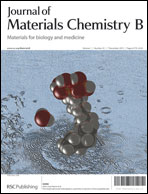A new method for the preparation of biocompatible silica coated-collagen hydrogels
Abstract
Silica–collagen scaffolds were obtained by covalent binding of an aminosilane to glutaraldehyde fixed collagen hydrogels, rendering a three dimensional network of silicon coated collagen fibrils. When compared to non-silicified collagen, silica containing matrices exhibited a 60 fold increment in the rheological properties. Moreover, acellular degradation by collagenase type I indicated that enzymatic digestion occurred at a slower rate for silica modified hydrogels, hence enabling a controlled degradation of the obtained material. In addition, fibroblastic cells seeded on silicified collagen matrices were able to adhere, proliferate and migrate within the scaffold for over 3 weeks as shown by MTT tests and hematoxylin–eosin staining. These results suggest that the herein described method could be useful in the design of materials for tissue engineering purposes.


 Please wait while we load your content...
Please wait while we load your content...